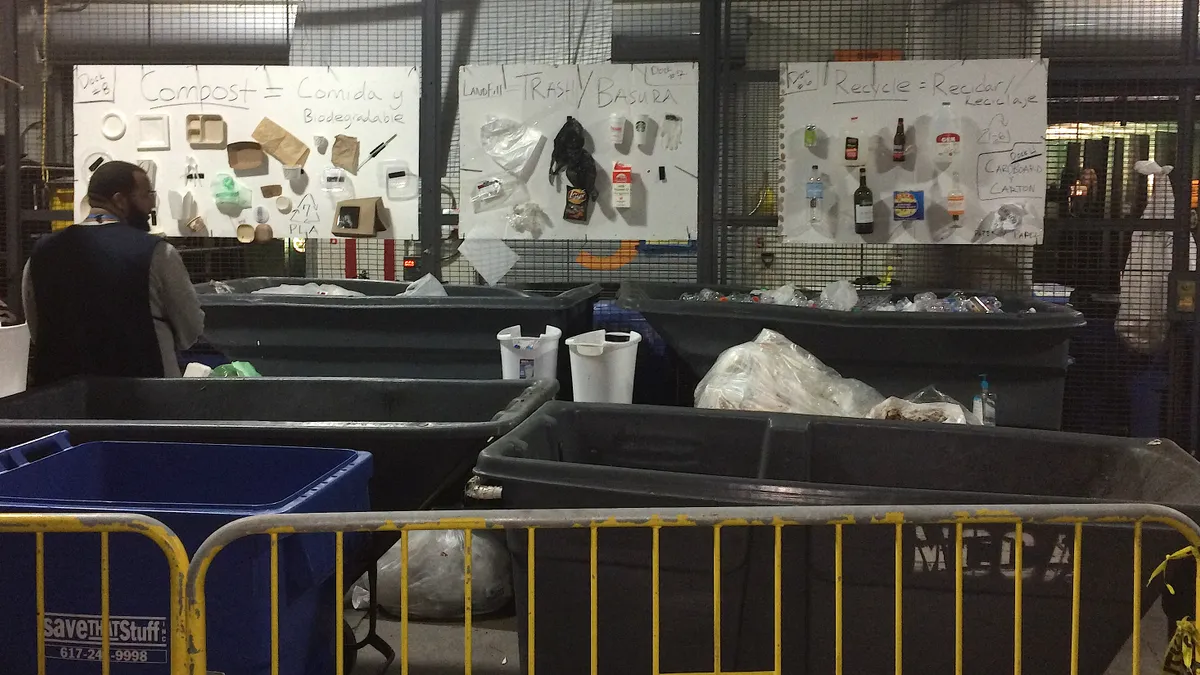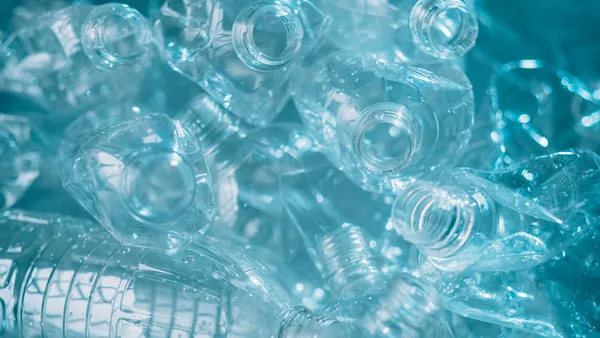UPDATE April 16, 2018: The U.S. Green Building Council and ArchitectureBoston Expo recently reported out results from the 2017 Greenbuild/ABX 2017 event in Boston, showing a near "zero waste" diversion rate. According to a new sustainability report, the event hit a 90.5% diversion rate when factoring in both the expo and an off-site party.
This served as a pilot for the TRUE Zero Waste event certification and was rated platinum level.
Hitting this target with nearly 25,000 attendees required extensive planning between service provider Save That Stuff, the host venue and local volunteers. An estimated 98% of all food waste waste was diverted for co-digestion. Separately, more than 1,500 pounds of food was donated to Boston Rescue Mission. Approximately 25,000 pounds of cement blocks, flooring, carpet and wood were donated to groups such as Habitat for Humanity.
Dive Brief:
- The Greenbuild International Conference and Expo, recently hosted in Boston during the week of Nov. 6, is the latest example that high diversion rates are possible at large-scale events with careful planning. Organized by Informa Exhibitions and presented by the U.S. Green Building Council (USGBC), this process started nearly six months ago with regular communication between staff at the Boston Convention and Exhibition Center (BCEC), local service provider Save That Stuff and other contractors.
- For exhibitors, this meant strict requirements about the material used to construct and transport their booths. In recent years, the USGBC has stipulated details such as non-vinyl table cloths and a certain percentage of recycled content in carpeting. For attendees, this meant using bins for either refuse, recycling or organics. More than 300 volunteers were scheduled in shifts to staff each bin cluster across the 516,000 square-foot exhibition space.
- This source-separated material was then collected via carts and brought back to the loading dock for additional sorting. With the exception of bags from restrooms — where paper towels were separated — everything was manually inspected by BCEC staff. Material was sorted well beyond traditional categories, down to bales worth of plastic film and bags of different color pallet strapping.
Dive Insight:
Recycling at large-scale events — even those for sustainability professionals — isn't often that successful. Keeping up with material from hundreds or thousands of people is difficult without adequate staffing. Taking the time to carefully sort that material back-of-house after the fact is almost unheard of.
The USGBC has become increasingly ambitious with its goals since Greenbuild started in 2002. Because BCEC hosted the show in 2008, with service from Save That Stuff, all involved were ready for another round. The fact that this year's event added front-of-house organics bins, and the 2016 Los Angeles show achieved a 90% diversion rate, increased expectations.
This approach translated to the partner hotels where conference-goers were staying in the city and the Museum of Science where they attended a reception. The USGBC's goal was to divert at least 81% of waste from the week-long event, also including the BCEC's dozens of meeting rooms and industrial kitchen.
Food recovery was also an important component. The self-described world's largest event dedicated to "green building," which featured a "zero waste" section this year, wanted to set a strong example.
"It's really important for us to have our attendees connect with what we're doing," said Sarah Patterson, USGBC's director of conferences and events.
All of the organics were taken to Waste Management's local CORe facility, located next to Save That Stuff's recycling center, and run through twice to ensure maximum diversion. About a week after the event ended, the company was still processing some of the remaining non-organic material and working to measure diversion results. The final number will be known in the coming weeks.
Erik Levy, president of Save That Stuff, said that the painstaking attention of volunteers and BCEC staff had made for a relatively clean stream with minimal residual waste. Common materials included outside coffee cups, chip bags, broken crates or pallets, and floor sweepings such as plastic, tape or wood scraps.
Levy's company has worked on multiple large-scale shows at the BCEC, some with more attention to detail than others, and he agreed Greenbuild was an example that high diversion rates are possible at such events.
"The big thing they did a real nice job of was controlling the inputs," said Levy. "For the most part, after the breakdown of the show I was impressed that there was very little trash."














